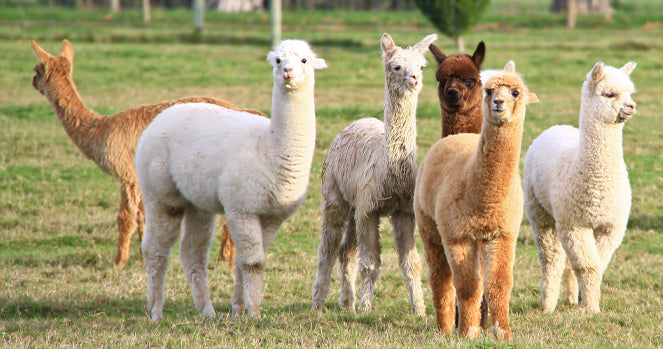Alpaca Body Condition Scoring
Combined with routine body weight monitoring, body condition assessment is a key indicator of an alpaca's nutritional status. It may help owners become aware of possible health issues before other signs appear.
Body condition scoring is important for alpacas for a variety of reasons. Overweight alpacas are more prone to heat stress, infertility, difficult births, poor lactation, neonatal mortality. Underweight alpacas may suffer nutritional deficiencies, poor skin/fiber quality, poor reproduction, and unthrifty crias.
For alpacas in particular, there is no substitute for hands-on evaluation of body condition. Variations in alpaca frame sizes mean that body weight comparisons among individuals may not be relevant, while longer fiber staples can mask significant differences in condition. Later stages of pregnancy can hide their actual status as well. It is important to always compare to a standard guide and review prior scores for the same individual, rather than comparing to other alpacas.
Assessment Guidelines & Tips
Body condition scoring (BCS) is performed by visual observation and feeling of the bony structures. A flat hand is passed firmly over important points on the body, feeling for sharp features and/or pressing to feel for excess fat. The goal is to assess the amount of cover between bony projections and the skin.
Alpaca Body Condition Scoring Guide

Key areas include:
The area around and just behind the shoulders
-
The shoulder bone should be palpable but not sharp; a thin alpaca will begin to show a diagonal crest from the point of the shoulder up towards the withers
-
The withers should be rounded and not sharp; a thin individual will have a sharp backbone around and behind this area
-
The sides should show a tuck-in just behind the shoulders; on an overweight alpaca, this area will be filled in
The ribs and spine
-
Should be slightly palpable with firm pressure, but without spaces between individual ribs or vertebrae, and without a spinal crest.
The zone between the ribs and hips
-
Vertebrae extending upward and to the sides should be palpable but rounded; on thin alpacas, these bones will begin to project, forming a vertical crest and horizontal “shelf”
-
The flank should have a smooth appearance, with a slight tuck in front of the hind legs. On thin individuals, there will be a sunken area just below the vertebral “shelf;” overweight alpacas will lose the inward tuck and show no contour at all.
The hips
-
Should be rounded but with palpable bony structures. Thin alpacas will have sharpness at hip points and near the tailbone, with a diagonal crest appearing along the rump; overweight alpacas will accumulate fat on top of the rump and near the tail, and bones will be difficult to feel.
The sternal/keel and inguinal areas, between the front and back legs
-
Thin alpacas will have little to no fat, appropriate alpacas will have slight to moderate fat, and overweight individuals will have obvious fat bulges.
The abdomen closest to the ground
-
Will show fat accumulation in overweight alpacas.
When to assess body condition
-
For all herd members, it is important to assess body condition throughout the year, as pasture and hay quality changes, and energy demands fluctuate with season and weather.
-
For reproductive females, it is important perform an assessment at mid-pregnancy and early to mid-lactation.
Interpreting Body Condition Score
This table shows the appropriate ranges of BCS for alpacas at various life stages. Individuals with scores outside of these ranges may need a medical evaluation or change in feeding plan.


